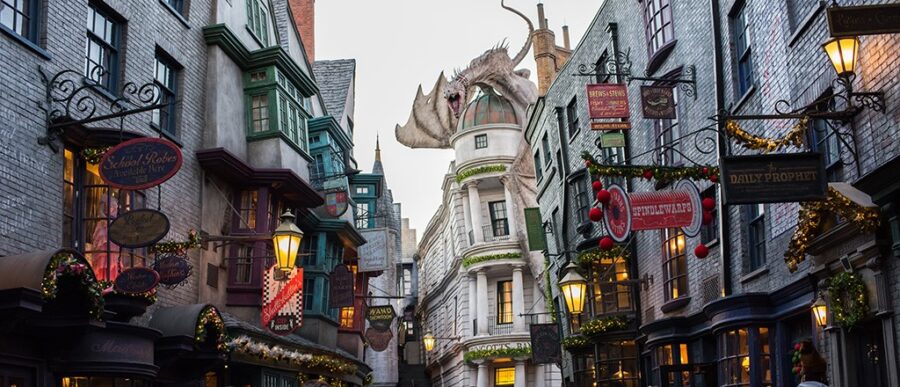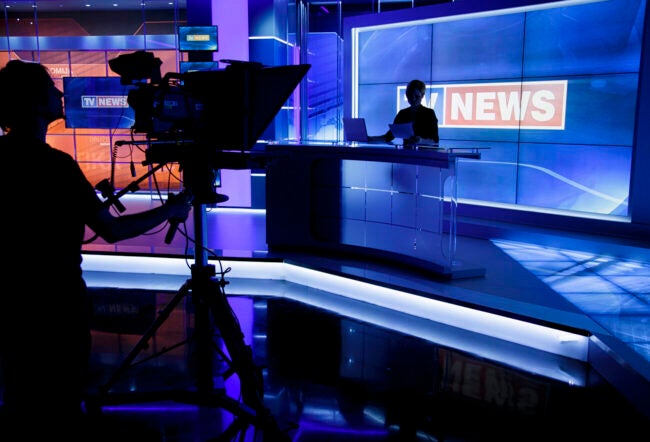From a virtual Harry Potter to digital wrist bands that hold your place in line, today’s theme parks are no longer the analog experiences of decades past. And they’re not done yet. Parks are using data analytics to deliver personalized experiences down to the individual level, among other innovations.
Wharton professors Christian Terwiesch (operations, information and decisions) and Nicolaj Siggelkow (management) recently discussed this trend on the Work of Tomorrow radio show, which airs on Sirius XM channel 111. They spoke with Eric Merz, creative producer in charge of the guest experience at Universal Orlando Resort, and Nick Franklin, a former executive vice president at Walt Disney Parks & Resorts who led the development of its “MyMagic+” project that digitized the user experience.
Following is an edited transcript of the conversation.
Christian Terwiesch: Eric, tell us about your work at Universal?
Eric Merz: My role is on the creative leadership side for attraction development. I’m responsible for ensuring that the creative vision of a project is delivered. It’s very much about ensuring that the guest’s experience meets the expectations of the project.
We’ve had intellectual property partners for previous attractions that we’ve done before, such as Harry Potter, Transformers and Men in Black. When you have a partner for these very popular pop-culture icons, you add in a layer of complexity because the partner also has a vested interest in the success of this product. Not only for us at Universal does the project have to go well and be a commercial success, but the IP partner also sees the success of that project as a direct reflection on their product and their brand. As a producer, we’re supposed to be the shepherds of that trust and champion the creative vision of the project.
Terwiesch: Being the Harry Potter fan that I am, help me understand how the digital technology will make me get to know [fictional Hogwarts headmaster and wizard] Albus Dumbledore or get me more connected to a broomstick. What has changed over the last 10 or 15 years with technology to enhance and augment the guest experience?
Merz: Interactivity is a very big part of what the themed entertainment industry is pursuing quite aggressively. Interactivity allows people to have very personalized, human moments where they feel like they have some agency in their experience.
“Interactivity is a very big part of what the themed entertainment industry is pursuing quite aggressively.” –Eric Merz
In the early days of attractions, you would just go on the ride, enjoy the experience, then step off of it. But you really didn’t have a role in that experience. You mentioned Albus Dumbledore as somebody that you would like to have an interaction with. In our Diagon Alley attraction, which was our most recent Harry Potter attraction, we have an area where you can interact directly with a Gringotts bank teller, so it feels very personalized. It feels very much like you’re having human interaction with this goblin, and it allows the guests to go on stage for a moment of time and feel like they’re a part of that story.
Nicolaj Siggelkow: What other ideas are you working on to create this customer segment of one, in a sense?
Merz: It’s a real challenge in this industry because our product is a mass-audience product. When you look at Disney, Universal, SeaWorld, Lego, Six Flags — all of these companies have millions of customers come through their parks. To be able to provide that one-to-one connection with the guests really is that challenge.
… Nick Franklin can share more about one of the things Disney has done, which is the MagicBand technology that was developed and is in operation right now. It allows the park to recognize each guest as an individual, and with that comes an understanding of what each guest’s preferences are. Guests wear this RFID wristband that’s now ubiquitous in the Walt Disney World resort, and it serves a lot of utility. It serves as their payment. It serves as their resort ticket. It provides certain entitlements, such as their ride return or FastPass return times.
But because it also identifies them as individuals, certain rides will actually detect these people and present different material that is personalized to them. They feel like the attraction is responding directly in a special way. It’s not the same experience for everybody, but something personalized and very unique, just for them.
Siggelkow: How are you using the information you’re gathering from your guests to think about new attractions or amenities?
Merz: Universal has opened their third theme park in Orlando. It’s a water park called Volcano Bay, and it’s a full-day resort experience. We introduced a new RFID wristband that every guest gets as they come into the park. The park has a tropical theme to it, and the wristband is called Tapu. It has a longer-range, two-way communication and a little screen on it. For guests, this wristband personalizes their day to the attractions that they want to go see.
Unlike FastPass or other types of ride wait-time systems, this one responds in real time to the rides you want to go on. You’re free to enjoy your day as you’d like, and the band will tell you when your ride is ready to go or if your ride is available sooner than you had planned. You’re not spending your day waiting in lines. You’ve expressed your preferences upfront. The system knows that, monitors that and creates a hassle-free experience.
It was a big challenge for Universal to do this, and it took an army of very technical people to sort through the logistics of how to manage such a large group of people in real time. The experience just keeps getting better and better as they learn more and refine the algorithms that direct people.
Terwiesch: How do you find out about guests’ needs?
Merz: In a lot of these experiences, you can infer certain data. But for the most part, when guests are going to a park, they’re very deliberate about the types of experiences they want. Even with this technology, there are multiple ways that guests can express their interests.
They can go through the Universal app. They can engage with the team members when they arrive, and the team members have different tablets that they can update preferences with. The nice thing about it is that as soon as the guest is identified, the system can immediately present to the team members previous information about this guest in a very quick, digestible manner. The team member can respond in a more personalized way rather than having to ask a whole bunch of questions about their day. The team members can see it all on a dashboard.
“The wristband is called Tapu Tapu. It has a longer-range, two-way communication and a little screen on it.” –Eric Merz
In the theme park industry, there has been a challenge in providing guest service. If you compare the experience of actually being in a park versus the process of planning a vacation — all of those online clicks and selections are tracked. That informs the website on how to respond and offer up the right information. The more guests are engaged in that online process, the more we get to know those guests so we can offer up things that would be of interest to them. It’s a really dynamic, one-to-one interaction.
Contrast that when they get to the theme park. After they’ve had this really rich, personalized experience, they get into the parks and they’re anonymous to the operators. They’re just people coming through. As much as through customer service and training you try to create those human moments and engage with them, you still don’t know enough about them. That’s where, as an industry, we’re hoping these technologies allow us to know more about the guests as they approach, as they engage in our attractions, as they engage with the team members directly.
Terwiesch: Have you found that not every customer wants to be known, not every customer feels comfortable with the technology?
Merz: Yes. It’s an important thing because familiarization with a stranger is kind of inherently creepy. If somebody you don’t know presents themselves as knowing you, it can be awkward. Now, some people lean into that. Some people are perfectly comfortable and want to step forward and engage directly with the Gringotts bank teller. But we design those attractions with a row in the back for people who don’t want to be in the spotlight. We’re certainly mindful of that.
Another aspect of your question is people’s comfort with, “How much do you know about me, and what are you doing with this data?” Back in the early to mid-2000s, we were asking what seems now like crazy questions. Do we really think everybody is going to have a cell phone with them when they go to the park? It sounds ridiculous now. I carry two phones with me all the time. I think society is getting more comfortable with the information that’s out there, especially when they see a benefit that comes back to them. If it feels one-sided for the guest, if it feels like the company or the service provider is taking advantage of that information, then I think the company has crossed the line.
Terwiesch: If I come back in five or 10 years, what will be the closest to riding a broomstick? We talked about analyzing big data and slicing it, but what do you see in terms of robotics and augmented reality?
Merz: I think you’ve nailed it. I think the real-time use of data without going through a cumbersome interface like a keyboard are really what’s on the horizon. I hope so, because I think it will keep people more present in their environment rather than distracted by their devices.
That’s one of the challenges in the entertainment experience, in particular. Although phones do provide a lot of utility and can help streamline your day and help you plan ahead, it’s really important theme parks are a physical experience. That’s why people go to these places. They want to step into that world and feel like they’re a part of it. You want to feel like you’re hopping on a broomstick and flying and playing Quidditch like Harry Potter, so we endeavor to do that with projection and 3D and wind effects and audio effects. But it needs to feel real. If we’re really successful with the technology, you never see the technology. The technology disappears.
“It’s the ability to place an individual in a time and a space that’s contextual to where they’ve been.” –Nick Franklin
Terwiesch: We turn now to Nick Franklin to continue this discussion. He was behind the development of the MagicBand at Disney. Nick, what’s different for park visitors now compared with 20 or 30 years ago?
Nick Franklin: Twenty or 30 years ago, we didn’t have cell phones, we didn’t have the entire digital ecosystem that all of us use in our everyday life. We would go into the theme park and, as Walt Disney said back in the day, “Leave the real world behind and step into a world of fantasy.”
What see today is that the folks who are still stepping into these fantasy worlds are bringing more of their everyday real world with them in the form of their devices. They use them as organizing devices. They use them as cameras. They use them to communicate. It’s also to enhance the experience of what’s going on around them. You would see people now in the park looking at their device because they’re figuring out what the wait times are for certain lines or seeing what their next FastPass is.
But you’ll also see people walking around the theme parks on a Sunday, checking their Fantasy Football scores. We are so used to having our digital security blanket with us that, from a theme park standpoint, if you force people to step away from that, you actually increase their stress level and make it harder for them to enjoy the theme park experience.
Terwiesch: One thing I cannot get at home is being blown away on a roller coaster and having that more hectic, more mechanical experience, which is ultimately not a digital one. Aren’t the rides still the main value proposition?
Franklin: You get a combination of things that the theme park provides. Certainly, there’s a connection to the three-dimensional embodiment of the stories that you’re familiar with. You can be sitting at home and watch Frozen and see Princess Elsa. But there’s a big difference between that and going into a theme park as a 6-year-old girl and being able to give Elsa a hug. There is a physical, tactical piece of it that the theme park provides. It also provides the thrills. It’s the reason people still go to the movies, even though many people have giant screens and fantastic digital imagery and sound systems in their own home.
There’s a social dynamic behind it. At the end of the day, humans are social creatures and we get value out of the shared experience. Part of a roller coaster being exciting is the physical senses that you feel, but part of it is also the thrill of having other people around you yelling and screaming.
Theme parks provide a dynamic social environment that is also enhanced by visceral experiences, tactical experiences. That’s what takes it beyond purely digital. I think the future of experience is the seamless blending of digital, physical, visceral and emotional. As your first guest said, the more those things all come together, the technology should ultimately disappear.
Siggelkow: On the one hand, we’re saying it’s the community, the joint experience. On the other side, we have the hyper-customization down to the personal level. How might we blend this in the future?
Franklin: If the physical environment is the first leg of the stool and the people are the second leg of the stool, the third leg of the stool is predictive analytics. What you now have is the fourth leg of the stool, which is the ability to marry that with contextual awareness. Things like the MagicBand, Bluetooth, low-energy beacons — it’s the ability to place an individual in a time and a space that’s contextual to where they’ve been.
The example I’ll give you is when I check into a hotel. If I’m traveling by myself on business, that’s one version of myself. If I check in with my wife at the same hotel, that’s a different version of myself. If I check in with my wife and kids, that’s yet a third version of myself. But it multiplexes further when you start to think, is it daytime or nighttime? Did I get off a plane or drive in? Is it rainy or sunny? All of those factors dictate my headspace and what kind of experience am I looking for.
“If you have the physical environment … predictive analytics and that contextual awareness, you now have the platform for great experience creation.” –Nick Franklin
Ultimately, if you have the physical environment, the great people to activate it, some level of predictive analytics and that contextual awareness, you now have the platform for great experience creation. The companies that can pull those things together have the ability to truly differentiate themselves.
You’re starting to see that predominantly in some of the theme park experiences. You’re seeing a lot of it in the cruise business, a fair amount of it in the hospitality business. You’re going to start to see it more in food and beverage. The retail companies that figure it out are going to make amazing differentiation for themselves.
Terwiesch: What methods would you advise companies to use?
Franklin: For us, it always came back to starting with the customer. Who are the categories of customers? What are those customer journeys that you are trying to provide? It doesn’t matter whether you’re an entertainment provider or a health care provider or a retail business. If you are a retail business that sells sports clothes, you need to think through, who are my customers? What do they need?
Make sure that at every touch point along the journey of the customer experience, you’re going through a process that says, “Are we doing this because it’s adding value to the customer experience, or are we doing this because we need it for our own processes and systems?” If it’s internal, you have to ask, “Why? What can we do about it? How can we get it out of the way?”
It’s very difficult because companies also have to [keep operating as they innovate.] They have organizational structures and P&Ls (profit and loss) [to consider]. To really deliver on the customer experience, you need to [cut] across all of that. It takes very thoughtful and intentional top-down management and leadership to break those silos down and make the customer the center point. But in my experience, the customer is the ultimate organizing principle.



